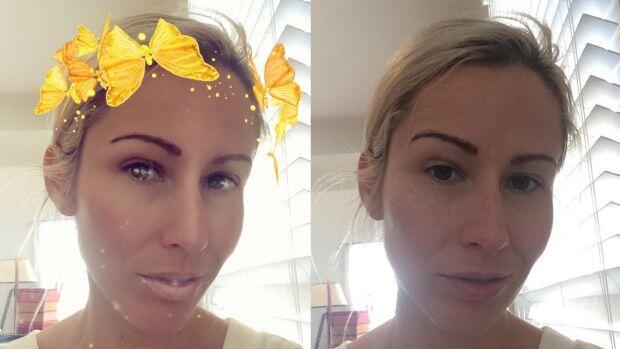I couldn’t quite work out what I was looking at. Well, I knew I was looking at my Instagram feed, and I knew I was looking at a photo of my friend and her four-year-old daughter. But there was something not quite right.
This wasn’t the first time I had seen someone sporting Snapchat’s butterfly halo, but it was the first time I realised there was more to the lens than sparkling gold wings flapping delicately around the hairline.
Ever-so subtly, the lens also slims the face, clears the skin and enlarges the eyes of the user. The result is instant “beautification”.
This might explain why the lens is so popular. It appears regularly in my social media feeds and boasts many celebrity fans. Many users disclose the beautifying effect when sharing the filter’s results. It’s little wonder there’s a temptation to conduct life from behind Snapchat filters on a permanent basis after discovering its enhancement qualities, such is the power of pretty.
Meanwhile, other users leave their image open for interpretation. As comments on such photos often prove, it is entirely feasible someone unfamiliar with Snapchat would take such images on face value (so to speak), butterflies aside.
The argument is, of course, that it’s harmless fun. And I grant you, it is fun. I downloaded Snapchat purely for this article and have not quite managed to delete it yet. The dog filter? Harmless fun. The old man? Hilariously harmless fun. The onion head? Random yet harmless fun.
The butterfly halo, though, along with a few other filters boasting similar beautification properties, seems fraught with potential harm.
I don’t want to take Snapchat to town on this issue. Sure, they’ve made a few unpleasant mistakes (the Bob Marley blackface incidentone example), but I don’t think lumping the problem of society’s beauty standards on them is fair play.
I’m also not here to beat down regular users of the butterfly halo. For starters, that would be hypocritical. I won’t be deleting my “experiment” anytime soon. My skin looks amazing and, although I know it’s fake, the confidence boost is still real.
However, also real is the discrepancy between the before and after photos. Real again is the suggestion – intentional or otherwise – that beauty requires a slimmer face, clearer skin (or whiter skin in the case of Snapchat’s flower crown lens) and bigger eyes. No matter what your starting point, this lens says, “OK, now you’re hot.” But does digital perfection comes at a cost?
Snapchat user Tarney Hall, 40, says she’s primarily interested in Snapchat for its entertainment value and does use the butterfly crown. She does, however, believe such filters could be detrimental to those who are more vulnerable, particularly young girls.
“When I was a little bit younger … [I would] plaster my social media with photoshopped photos of myself,” she says.
“I felt great because I looked beautiful in the pics, but I knew I didn’t look like that in person. I was so self-conscious [in public because] I felt that the real ‘un-photoshopped’ version of me was disappointing.
“So while it’s nice to see these prettier versions of yourself, I think you’re really setting yourself up for disaster.”
Try to define beauty and you might find yourself down a rabbit hole.
Study after study has attempted to confirm the science behind the perfect face. Facial symmetry is often mentioned. Denzel Washington is apparently beautifully symmetrical. Sexual dimorphism, describing the degree to which one appears “classically” masculine or feminine is another theory.
Then there’s the golden ratio. Also known as phi, the golden ratio is 1 to 0.618 and, it is argued, the more golden ratio proportions detectable, the more beautiful the face. This video illustrates the ratio on Florence Colgate, the woman voted as having Britain’s Most Beautiful Face in 2012.
The fact science can’t agree is reflective of society. Beauty comes in countless forms and that’s a good thing. Yet it’s the butterfly halo and not the rainbow vomit that is staking the biggest claim on social shareability. The more we perpetuate the message, the more confined the definition of beauty becomes.
Snapchat is fun, when it is used in such a vein. Not so much when it is used by the vain. Keep it real. Everyone has a butterfly halo, but everyone’s an onion, too.
Source: TheSydneyMorningHerald











